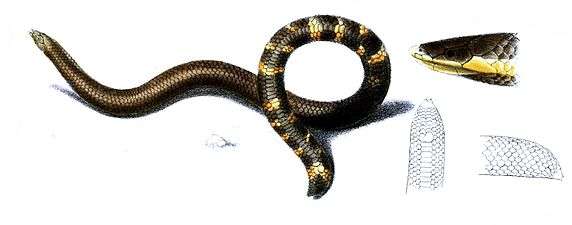Uropeltis pulneyensis
| Uropeltis pulneyensis | |
|---|---|
 | |
| Palni shieldtail | |
| Scientific classification | |
| Kingdom: | Animalia |
| Phylum: | Chordata |
| Class: | Reptilia |
| Order: | Squamata |
| Suborder: | Serpentes |
| Family: | Uropeltidae |
| Genus: | Uropeltis |
| Species: | U. pulneyensis |
| Binomial name | |
| Uropeltis pulneyensis (Beddome, 1863) | |
| Synonyms | |
| |
Uropeltis pulneyensis, commonly known as the Palni shieldtail, is a species of uropeltid snake endemic to the Western Ghats of India.
Description
Description after Beddome (1864: 180): "Rostral rather obtuse, produced back between the nasals, and touching the frontals [=prefrontals], nasals not meeting; eye small, in [the] front of the ocular shield; no supraorbitals; vertical [=frontal] 6-sided; occipitals [=parietals] rounded behind; 4 upper labials. Scales round the neck 19, round the body 17; subcaudals, male, about 12, female 6-8. Tail [laterally] compressed, ending in a small spinose keel, more or less bicuspid. Scales of the tail all smooth. Colour uniform earthy brown; a lateral bright yellow streak from the labials continued on each side of the trunk, about 1 or 1½ inch in length; a few minute yellow specks on the back; belly with broad bright yellow transverse bands, very irregular as to number and shape; yellow markings about the vent and tail."
After Beddome (1864: 180), pulneyensis and wynandensis "...differ from the typical form of this genus in their much smaller size and in the absence of a supraorbital shield. As, however, they have the same [laterally] compressed tail, I prefer keeping them in this genus to making a new genus for them."
Boulenger (1893) adds the following details:
Adults may attain a total length of 38 cm (15 inches).
Portion of the rostral visible from above longer than its distance from the frontal. Frontal longer than broad. Diameter of the eye ½ the length of the ocular shield. Diameter of the body 30 to 38 times in the total length. Ventrals about twice as large as the contiguous scales, 161-180. Tail somewhat laterally compressed. Usually some of the terminal dorsal scales of the tail with faint keels.[3]
Geographic range
It is found in southern India (Palni and Travancore hills, 5,000-7,000 feet).
- Type locality of Plectrurus pulneyensis: "Pulneys at an elevation of 7,000 to 8,000 feet".
- Type locality of Silybura guentheri: "High Wavy mountain, Madurai district, 5000 feet elevation".[2]
Footnotes
- ↑ Srinivasulu B, Srinivasulu C; Vijayakumar SP; Ramesh M; Ganesan SR; Madala, M. (2013). "Uropeltis pulneyensis". IUCN Red List of Threatened Species. Version 2014.3. International Union for Conservation of Nature. Retrieved 20 January 2015.
- 1 2 Uropeltis pulneyensis at the Reptarium.cz Reptile Database. Accessed 13 December 2007.
- ↑ Boulenger GA. 1893. Catalogue of the Snakes in the British Museum (Natural History). Volume I., Containing the Families...Uropeltidæ... London: Trustees of the British Museum (Natural History). (Taylor and Francis, printers). xiii + 448 pp. + Plates I-XXVIII. (Silybura pulneyensis, pp. 147-148).
Further reading
- Beddome RH. 1863. Descriptions of New Species of the Family Uropeltidæ from Southern India, with Notes on other little-known Species. Proc. Zool. Soc. London 1863: 225-229 + Plates XXV-XXVII.
- Beddome RH. 1864. Descriptions of New Species of the Family Uropeltidæ from Southern India, with Notes on other little-known Species. Ann. Mag. Nat. Hist. (3) 13: 177-180.
- Beddome RH. 1866. Notes upon the snakes of the Madras Presidency. Description and plate of a new species of snake of the family Uropeltidae from the Pulney Mountains. Madras Quarterly Journal of Medical Science 9: 207-208 (228?). [Reprint: 1940. J. Soc. Bibliogr. Nat. Sci., London 1 10: 314.]
- Beddome RH. 1878. Description of six new Species of Snakes of the Genus Silybura, Family Uropeltidæ, from the Peninsula of India. Proc. Zool. Soc. London 1878: 800-802.
- Beddome RH. 1886. An Account of the Earth-Snakes of the Peninsula of India and Ceylon. Ann. Mag. Nat. Hist. (5) 17: 3-33.
- Boulenger GA. 1890. The Fauna of British India, Including Ceylon and Burma. Reptilia and Batrachia. London: Secretary of State for India in Council. (Taylor and Francis, printers). xviii + 541 pp. (Silybura pulneyensis, p. 260).
- Günther ACLG. 1864. The Reptiles of British India. London: The Ray Society. (Taylor and Francis, printers). xxvii + 452 pp. + Plates I-XXVI. (Rhinophis pulneyensis, pp. 187-188 + Plate XVII, figure C).
- Smith MA. 1943. The Fauna of British India, Ceylon and Burma, Including the Whole of the Indo-Chinese Sub-region. Reptilia and Amphibia. Vol. III.—Serpentes. London: Secretary of State for India. (Taylor and Francis, printers). xii + 583 pp. (Uropeltis pulneyensis, p. 85).
- Williams EE. 1959. The Occipito-vertebral Joint in the Burrowing Snakes of the Family Uropeltidae. Breviora (106): 1-10. (Uropeltis pulneyensis, figures 3A & 3B).
External links
| Wikimedia Commons has media related to Uropeltis pulneyensis. |
